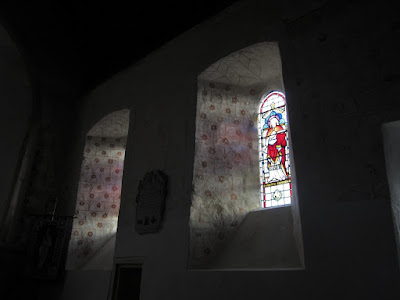We had lunch in the Calleva Arms. Calleva Atrebatum, we are told, is the Roman name of the town they built near the present village in the first century AD.
Our first stop was the ancient Church of St Mary the Virgin, but we arrived ten minutes before a baptism was due to take place, so diverted to the site of the Roman town walls and amphitheatre instead.
We walked along the drove cutting through the centre of the site. Now it's fields; then there was a grid of streets with houses, public buildings and a forum. Discoveries are still made during the annual summer excavations by Reading University.
I bet it didn't include alpacas.
There were several groups of people wandering about trying to find the amphitheatre. We were misdirected twice before we found it.
I had that knot of emotion in my throat again as I walked into the middle.
No evidence survives to indicate the sort of entertainment taking place here. Shows involving gladiators or wild beasts might have been too expensive, but blood sports with bulls, dogs and bears are possibilities, and public executions would have been carried out.
The opposing entrance/exit
One of two semi-circular niches recessed into the seating banks on the east-west axis. They might have been refuges for 'participants' in the 'games'; elsewhere, evidence has been found suggesting that such recesses contained altars to Nemesis.
 On our arrival, we'd noticed a slightly alarming sign which said the car park would be locked at 4pm, and time was getting on, so we hurried back via the walls on one side of the site.
On our arrival, we'd noticed a slightly alarming sign which said the car park would be locked at 4pm, and time was getting on, so we hurried back via the walls on one side of the site.  Silchester boasts 'some of the best preserved Roman town defences in England' - and they are quite impressive.
Silchester boasts 'some of the best preserved Roman town defences in England' - and they are quite impressive.  Back, then, to St Mary the Virgin, where the only remnant of the baptism was a disposable nappy left behind in the car park.
Back, then, to St Mary the Virgin, where the only remnant of the baptism was a disposable nappy left behind in the car park.  The church is ancient and a far more modern site than the walls we'd just walked. The earliest surviving masonry dates from the early 12th century, though its position, tucked up inside the east wall of Calleva, suggests it inhabits a site held sacred in pagan times.
The church is ancient and a far more modern site than the walls we'd just walked. The earliest surviving masonry dates from the early 12th century, though its position, tucked up inside the east wall of Calleva, suggests it inhabits a site held sacred in pagan times.  As soon as you step inside, you see the plain, late 14th/early 15th century font - clearly still in use - with its beautiful 1985 corona by Giuseppe Lund, representing shoots growing from seeds to maturity. Behind it, a modern memento mori in the form of the striking Carpe Diem window by Jon Callan, a memorial to two young people, Andrew Culbert and Sophie Wilsdon, who died in accidents within six months of each other.
As soon as you step inside, you see the plain, late 14th/early 15th century font - clearly still in use - with its beautiful 1985 corona by Giuseppe Lund, representing shoots growing from seeds to maturity. Behind it, a modern memento mori in the form of the striking Carpe Diem window by Jon Callan, a memorial to two young people, Andrew Culbert and Sophie Wilsdon, who died in accidents within six months of each other.  The chancel screen, dated by its carved pomegranates to the time of Henry VIII's marriage to Catherine of Aragon ...
The chancel screen, dated by its carved pomegranates to the time of Henry VIII's marriage to Catherine of Aragon ...  As someone brought up in the Methodist church and attuned to the Virtues of Plain, I wasn't surprised to learn that the pulpit dates from the Commonwealth, c1650. The sounding board above it is 11 years earlier and illustrates the change in prevailing attitude towards church furniture of the intervening years.
As someone brought up in the Methodist church and attuned to the Virtues of Plain, I wasn't surprised to learn that the pulpit dates from the Commonwealth, c1650. The sounding board above it is 11 years earlier and illustrates the change in prevailing attitude towards church furniture of the intervening years.  Quite a few traces of paint have been uncovered that give the imagination a tiny glimpse of what it might have been like inside before the wielding of great brushes of whitewash.
Quite a few traces of paint have been uncovered that give the imagination a tiny glimpse of what it might have been like inside before the wielding of great brushes of whitewash.  The tomb of Eleanor Baynard, depicted in her widow's weeds, who survived the first incursion of the Black Death and died some time after 1359.
The tomb of Eleanor Baynard, depicted in her widow's weeds, who survived the first incursion of the Black Death and died some time after 1359. 





















No comments:
Post a Comment